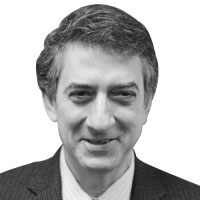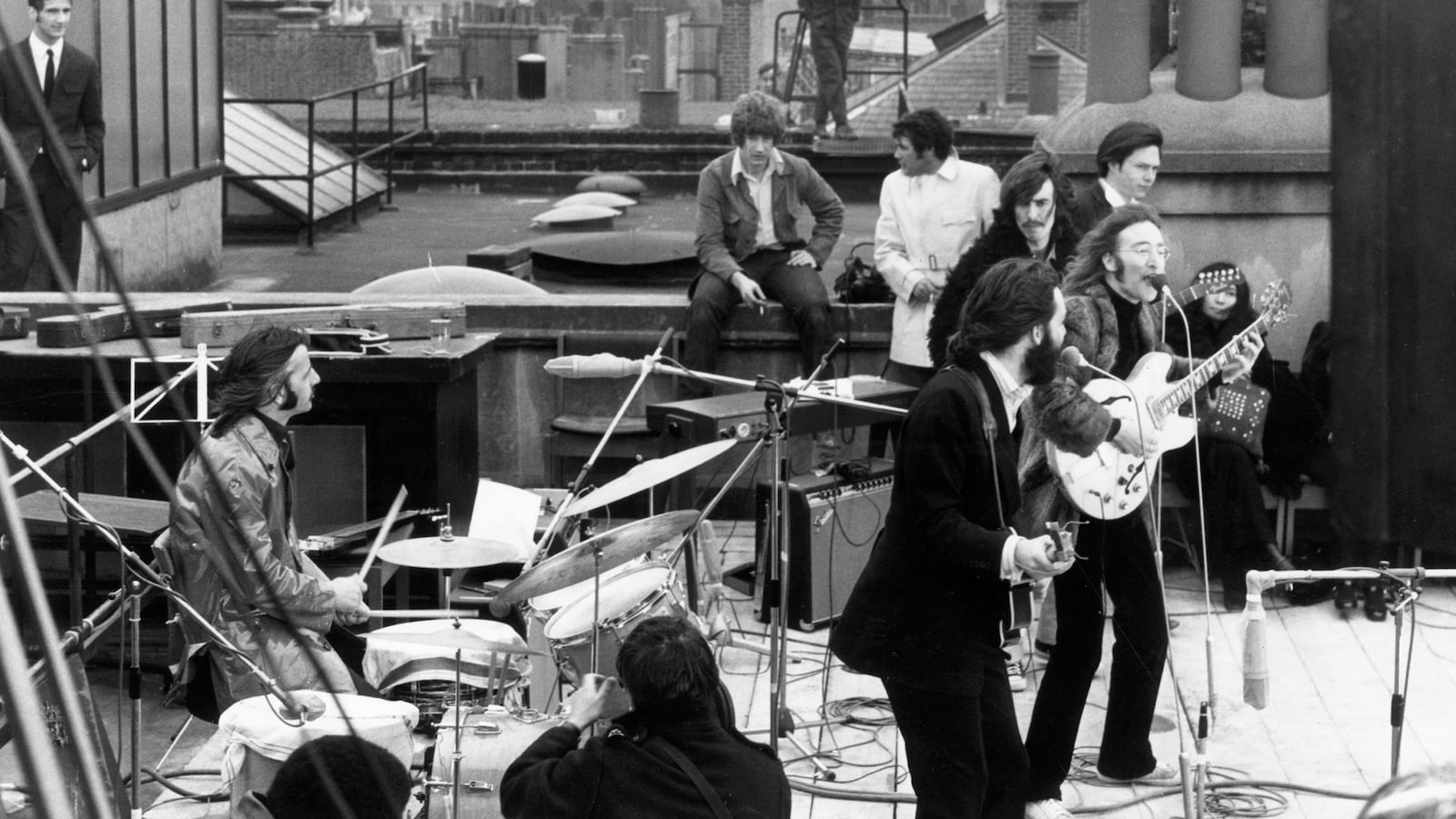One thing I’ve always lamented as a Beatle person is that they didn’t follow Paul’s suggestion and mount any sort of tour in 1969. He ached to. Paul needed to perform like he needed to breathe, as their biographer Philip Norman put it, an assertion whose truth he’s proven a hundred times over in the intervening years he’s spent pleasing fans around the world (at 76, he’s hitting South America in March, and the States again starting in New Orleans May 23). He felt they owed it to their fans.
The others, with varying degrees of hostility, disagreed. George most strongly. He seems to have had the old days fixed in his head, the screaming pre-teen girls overwhelming their tiny Vox amps. John, by accounts I’ve read, was indifferent-to-negative, preoccupied now with Yoko and their happenings, like their appearance onstage at the Royal Albert Hall—the only venue, incidentally, where the Beatles and the Stones ever shared a bill, on September 15, 1963—in December 1968 in a large white bag. Ringo leaned against but would have done whatever the others agreed to.
Paul was right, though. The world had changed a lot from 1966 (when they last toured) to 1969. For one thing, pop music had become rock music. It wasn’t for 14-year-old girls anymore. When the Beatles last played live, pre-teen girls were coming to the concerts, chaperoned by their parents, and screaming their heads off. By 1969, the teeny-boppers had switched to the Osmond Brothers, and rock audiences consisted of college-age kids who were getting way too stoned to scream, and actually listening to the music. George, ironically, would have loved it.
Something else had changed dramatically: musical equipment. It was just after the Beatles stopped touring that Jim Marshall and other pioneers of amplification started making bigger and bigger amp set-ups that could jolt a crowd as large as, say, the 30,000 (or more) who attended the Monterey Pop Festival in June 1967. Jimi Hendrix used Mr. Marshall’s famous stacks. Others used something else. The point was, in 1966, the Beatles were playing basketball arenas with amps designed for ballrooms one-tenth the size (before the Beatles came along, no one had even envisioned that 20,000 or more people would come out to hear a live musical performance of any kind). By 1969, technology had solved that problem (well, volume anyway; sound quality would have to wait a bit).
So they could have done it, and they’d have found it would have been a completely different experience. What would they have been like, the older Beatles, the hippie Beatles, playing to thousands of stoned hippies through a wall of Marshall amps? It was also often said in those days that they were making music now that couldn’t be reproduced on a stage. That was true with respect to parts of Sgt. Pepper and Magical Mystery Tour, but not to other stuff. Imagine a set list heavy on White Album and Abbey Road tracks, with a few of the old ones salted in for a laugh; a show that opened, maybe, with “Back in the USSR” and “Dear Prudence” and closed with an encore of “Revolution” and “Hey, Jude”? With “Helter Skelter” and “Yer Blues” and “While My Guitar Gently Weeps” (with Eric on board) in between? Still preserved for us on high-quality film and digitally remastered recording tape. Paulie, they owe you an apology.
We never got that tour. What we got, instead, was the one show that exists, which happened 50 years ago today, at around noon London time, when the group clambered up the stairs of No. 3 Savile Row and performed what was really less of a concert than a rehearsal or a run-through of a few new numbers. It was impromptu, rough, occasionally a little out of tune; but it was the Beatles, and it still sprinkled some magic on the world that hasn’t left.

The Beatles, John Lennon, George Harrison, Paul McCartney, Ringo Starr, 1969.
Everett CollectionQuick backstory, which you know if you’ve read this far: They decided in late 1968 at Paul’s urging to “get back” to their roots—play just as the four of them, as they once had. They’d film it and see what happened. They started in Twickenham Studios, but they hated it and were really getting on one another’s nerves, which they sort of had been anyway. At George’s suggestion, they switched venues to the building they’d bought to set up their company, Apple, at No. 3 Savile Row.
Savile Row, in central London, is a narrow street parallel to and just west of posh and busy Regent Street. Historically, it’s home to the “bespoke” (custom-made) tailors who’ve spent centuries outfitting kings, princes, earls, admirals, peers, royal equerries, whatever. These places have names like Huntsman & Sons, Dege & Skinner. At No. 1 sits maybe the most venerable of them all, Gieves & Hawkes. Thomas Hawkes was once “helmet, hat, and cap-maker to the King.” I bought a suit there once—off the rack, not bespoke. The clerks wear tails, and every sentence ends with “sir.” “Very good, zah.” “A nice fit indeed, zah.” “Something for the missus, zah?”
I stood outside Gieves & Hawkes that day 12 or so years ago imagining the local reaction to the sudden appearance in 1968 of the battery of freaks and flower-children that suddenly started populating this most button-downed of streets, running in and out of No. 3 at all hours. At one point, a group from San Francisco parked themselves in reception waiting to speak with John and Yoko about their plans to found an alternate universe in the Fiji Islands. At another, a few members of the Hell’s Angels showed up.
All this was not to mention the principals themselves, who by late ’68-early ’69 assumed a very different form than the one that had besotted the nation in 1963. Hair down to their shoulders. Beards and mustaches. Strange clothes. Drugs. Yoko. She did little to endear herself to the British public, Lord knows, but to much of that public, in a nation then lending a sympathetic ear to Enoch Powell’s rantings against Pakistanis, the mere fact that she was Japanese was all they wanted to know.
They were getting along better at Apple than at Twickenham, helped by Billy Preston’s presence. George had invited the ex-Little Richard keyboardist to join them, and the other three were on better behavior. Talk turned to the idea of a live performance of these new songs to serve as culmination for the film. The Roundhouse Theater in Camden Town. An ocean liner. An amphitheater in Tunisia. In the end, they couldn’t be bothered. They decided just to play on the roof and film and record it. They settled on the 29th, but it rained, so they did it on the 30th. George Martin was in the basement at the mixing board. It was a Thursday.
You can’t see that much of it now. I looked on YouTube and it seemed that you can only see “Get Back” and “Don’t Let Me Down.” Every once in a while, fuller versions pop up, but they get taken down. I guess this is Paul, or Paul and Ringo, or maybe just some lawyers somewhere (last fall, McCartney said a new version of the full Let It Be film would be released in the spring of 2020, to mark the 50th anniversary of the movie’s debut).
What you can see, though, is poignant; a reminder of how much simpler fame was back then, and of the group’s own insistent and always laudable lack of pretension. They just plugged in, tuned up, and played. They were five stories up above street level. Camera shots in the movie from the street make it obvious that passersby couldn’t see them at all. Did they even know it was the Beatles? No one would have known the songs. The “Get Back”/“Don’t Let Me Down” single came out four months later, and the rest of the songs, “I’ve Got a Feeling” and “Dig a Pony” and so on, weren’t released for more than a year. It seems quite likely that many or even most of the people below had no idea what they were hearing.
Some did, though, and they climbed up onto adjacent fire escapes or roofs to have a look. Several people amassed on the Gieves & Hawkes roof—maybe employees, maybe not. Anybody could go anywhere. Security? I’m sure they didn’t even think of it. No one thought, then, that anyone would harm a rock star, least of all a Beatle.
They’d been through a lot, and they were winding toward the end. They were getting tired of being Beatles. But even so, when they played, all that evanesced. There’s still no sound in popular music history quite like John Lennon and Paul McCartney singing harmony, and the jubilant looks they trade while doing so on “One After 909,” especially on the “move over once/move over twice” bit, are priceless. There were snags: On the last performance of “Get Back,” which closes the set, someone seems to have accidentally unplugged John’s amp for a bit, and the first of his two solos is inaudible. In exasperation, he turns instantly to old comrade Paul, exactly as he might have in Hamburg’s Star Club eight years earlier.
The bobbies came and shut them down after 42 minutes, and that was it. The last live notes they ever played together. At the time, of course, no one knew it was a historic moment. For the police and the men over from the City on lunch break having their girths measured, it was just an impertinent annoyance. I think that’s exactly how the Beatles would have wanted it.






